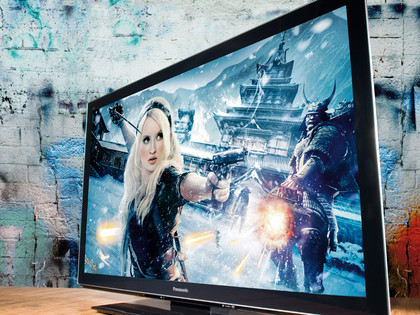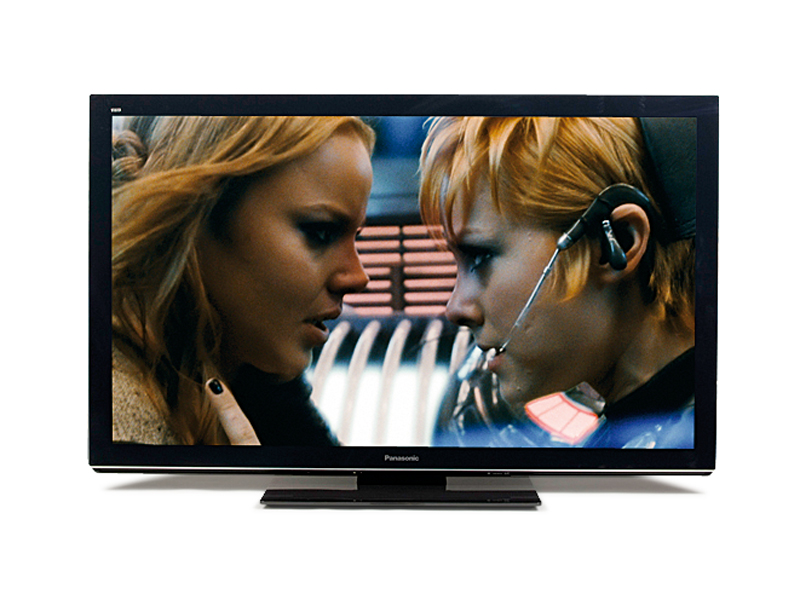TechRadar Verdict
Pros
- +
Incredible build
- +
Stunning cinematic picture quality
Cons
- -
Picture lacks a little brightness
- -
Needs a 3D picture preset
- -
Judder with 50Hz
Why you can trust TechRadar
Panasonic has tried all manner of different TV sizes over the past few years, so I guess we shouldn't be surprised to find it delivering another size 'first' in the form of its debut 55-inch model.
The TX-P55VT30B is the only 55-inch model announced for Panasonic's 2011 range to date, and it belongs to the brand's flagship, 3D-capable TV series.
So, while we've already lauded Panasonic's new GT30 plasmas to the heavens, the P55VT30 promises even more.
The screen starts establishing its flagship credentials right away by being exceptionally slim for a plasma TV; enjoying a 'single layer' finish; and being built like the proverbial brick outhouse; wall mounters and people with weak backs take note. I suppose some people might find the sizable bezel width a turn off, but heck, if you're up for buying a 55-inch TV, then another couple of inches of frame isn't really a big deal, is it?
More evidence of the P55VT30's uncompromising nature can be seen with its connections. The four v1.4 HDMIs, for instance, should satisfy even the most ambitious of AV setups. There's an LNB input alongside the usual RF jack, too, revealing that the P55VT30 carries a Freesat HD tuner, as well as a Freeview HD one.
Then there are the P55VT30's multimedia connections, which comprise an SD card slot, three USB ports, a LAN port and Wi-Fi courtesy of an included USB dongle.
The video/music/photo file compatibility of the USBs and built-in DLNA PC network support is extensive. Plus you can, of course, take the P55VT30 online with Panasonic's Viera Connect service.
Sign up for breaking news, reviews, opinion, top tech deals, and more.
Range topper
The VT30 occupies the top slot in Panasonic's TV hierarchy, but shares much of its hardware with the GT30 range. So what, exactly, are the differences?
Well, firstly, both the SD slot and the USB ports on the VT30 enable you to record from the TV tuners, whereas with the GT30 TVs you can only record to USB HDD. Also, the Panasonic USB Wi-Fi dongle included with the VT30 isn't included with the GT30s.
The P55VT30 ships with two pairs of active shutter 3D glasses thrown in, too, whereas you get none with the GT30s. Given that Panasonic's active spex cost around £100 each, this advantage, in conjunction with the thrown-in Wi-Fi dongle, explains much of the price gap between the VT and GT30 ranges.
The remote control supplied with the P55VT30 is better than that shipped with the GT30s as well. It's weightier, more attractive and has a really premium feel. You can even illuminate some of its keys, which are superbly responsive.
The other key 'extra' the P55VT30 brings to the table is an extra filter layer tucked within its screen composition, designed to deliver an even better black level response. To be clear, this comes on top of the new louvre filter and other advances found on the lower GT30 range.
The Viera Connect platform hasn't obviously expanded since we last covered it; there's still no sign of the promised high quality games or health and fitness tools. But highlight services like the BBC iPlayer, Eurosport, the AceTrax movie rental/ purchase site, and Skype (via an optional extra webcam) still make it a very worthwhile addition.
The P55VT30 enjoys the endorsement of both THX and the Imaging Science Foundation (ISF), giving it third-party kudos for both its performance standards and its set-up flexibility. The set-up tools extend to gamma presets and white balance fine tuning (once you've activated the Advanced ISFcc options via the Set up menu).
Panasonic's plasmas have traditionally impressed with 3D, so I couldn't resist starting beginning my audition with 3D Blu-rays of Avatar and The Green Hornet. And I'm glad I did. Particularly striking is how bright and colour-rich 3D images look compared with those of last year's 3D plasmas. This pays particular dividends when it comes to reproducing more shadow detail during 3D viewing, avoiding the rather crushed, empty dark areas noted with 2010's models.
The P55VT30 also continues the Panasonic plasma theme of delivering full HD 3D while suffering practically no crosstalk noise at all. The nasty double ghosting issue (crosstalk) still found on some LCD 3D models this year is here just not an issue of any significance. Not having any crosstalk to squint through also allowed me to appreciate how the 55-inch screen shows off the full HD splendour of the active 3D format to a degree you don't see with smaller models.
Not for the first time, I was struck by how much size matters for 3D viewing. My only gripe would be that there isn't a 3D picture preset, leaving me having to calibrate a good one myself (based on a toned down version of the Dynamic preset).
Filtered blacks
Turning to 2D, the picture advantage offered by the VT30 series' exclusive contrast filter becomes apparent. Black level response during dark sequences such as the main ballet sections of Black Swan is even more intense, deep and rich than it is on the GT30 models. The difference is subtle rather than earth-shattering, but for the P55VT30's target 'enthusiast' market, even a small advantage in black level response extremely desirable.
In most other ways, the P55VT30's pictures deliver similar strengths to the GT30 series. Colours are richer and more natural than those of any previous Panasonic plasma generation. They're subtle too, with little to no evidence of colour striping or blotching.
HD images look outstandingly crisp and detailed as well, reminding us strongly of how the HD advantage is directly proportionate to the size of screen you're watching.
The P55VT30 isn't a bad standard-def performer, either. This is especially true with DVDs, but the set's upscaling processing can add detail to Freeview SD broadcasts without adding noise. There's not as much sharpness to these pictures as there is with some rival TVs, but the Panasonic's more 'laid back' approach is not without its charms.
There are some problems with the P55VT30's pictures. The first finds 50Hz pictures suffering more judder than we'd like, leading to some double imaging at times. You can greatly improve this, though, by using the set's Intelligent Frame Creation processing on its Mid level – a setting which doesn't introduce many distracting processing side-effects.

Power consumption: Watts
There's a CATS mode, which uses a sensor to adjust brightness according to ambient light. This is turned off unless specified - it's on by default.
White screen results
315W (mean value, fluctuates between 310-320W Default, power save off, CATS on, light room)
260W (Default, power save off, CATS on, dark room)
300W (Default, power save on, CATS on, light room)
255W (Default, power save on, CATS on, dark room)
285W (Default, power save on, CATS off)
375W (Default, power save off, CATS off)
Test footage results
80W low - 170W high (modal value: approx. 140W ), with volume maxed and power saving/CATS on.
Power consumption drifts quite a lot, though the power saving features work well.
Contrast ratio
Claimed: 'Brilliant Contrast'
Measured:
Normal mode: 51,000:1 (CATS/power saving off: 0.00fL 0IRE/15.0fL 100IRE)
'dynamic' mode: 50,000:1 (CATS/power save off, 0.00fL 0IRE/14.6fL 100IRE)
Cinema mode: 49,000:1 (CATS/power save off 0.00fL 0IRE/14.2fL 100IRE)
THX mode: 49,000:1 (CATS/power save off 0.00fL 0IRE/14.4fL 100IRE)
Gaming mode: 47,000:1 (CATS/power save off 0.00fL 0IRE/13.6fL 100IRE)
Picture mode: 48,000:1 (CATS/power save off 0.00fL 0IRE/14.1fL 100IRE)
Professional1: 10,000:1 (CATS/power save off 0.001fL 0IRE/14.7fL 100IRE)
Professional2: 50,000:1 (CATS/power save off 0.00fL 0IRE/14.6fL 100IRE)
Colour accuracy: 6500K (Modes: Cool/Normal/Warm)
Presets
1. Cool (normal): 9,700K
2. Normal (normal): 6,900K
3. Warm (normal): 6,000K
Different picture modes with 'Normal' colour balance preset:
Dynamic: 6,900K
Cinema: 6,800K
THX mode: 6,000K
Game: 6,800K
Photo: 6,800K
Professional1: 6,000K
Professional2: 6,000K
isfccc controls are available, but the warm preset is spot on. Interestingly, while True Cinema mode gives less impressive contrast figures, its colour temperature is slightly closer to 6500K.
Configured:
Contrast ratio: 50,500:1 (CATS/Power save off, 0.00fL 0IRE/14.5fL 100IRE)
Colour Temperature: 6500K
Notes
A lot of settings with subtle differences. The colour temperature measurements, as we present them, look similar whilst the balance of red green and blue actually alter the image quality noticably while maintaining the luminance. The contrast is also maintained throughout the various picture modes.
GT versus VT

Another issue is the extra contrast filter in the P55VT30 slightly reducing the picture's brightness. This arguably makes the GT30 series a better choice for those with a bright room who don't mind the range's maximum 50-inch size.
For Home Cinema Choice, though, serious movie viewing is everything (the clue's in our name!) So, with this in mind and our blackout blinds down, we have no hesitation in declaring the P55VT30 the best domestic plasma screen we've seen so far.
Better even than the much-missed Pioneer Kuros? Well, the last of the Kuros perhaps achieved a more dynamic picture, but the Panasonic has deeper black levels, and of course many more features.
The TV's built-in audio system is solid, but given it combines stereo speakers and a separate woofer, I'd hoped for more than that. There's more bass than usual, but the soundstage still lacks a little power and dynamic range. Still, most potential P55VT30 buyers will use a separate surround system.
Anyway, the P55VT30 is really all about its pictures, and they're so good, the only remaining question is whether we should be saving up for the 65-inch version...
Follow TechRadar Reviews on Twitter: http://twitter.com/techradarreview

John has been writing about home entertainment technology for more than two decades - an especially impressive feat considering he still claims to only be 35 years old (yeah, right). In that time he’s reviewed hundreds if not thousands of TVs, projectors and speakers, and spent frankly far too long sitting by himself in a dark room.
